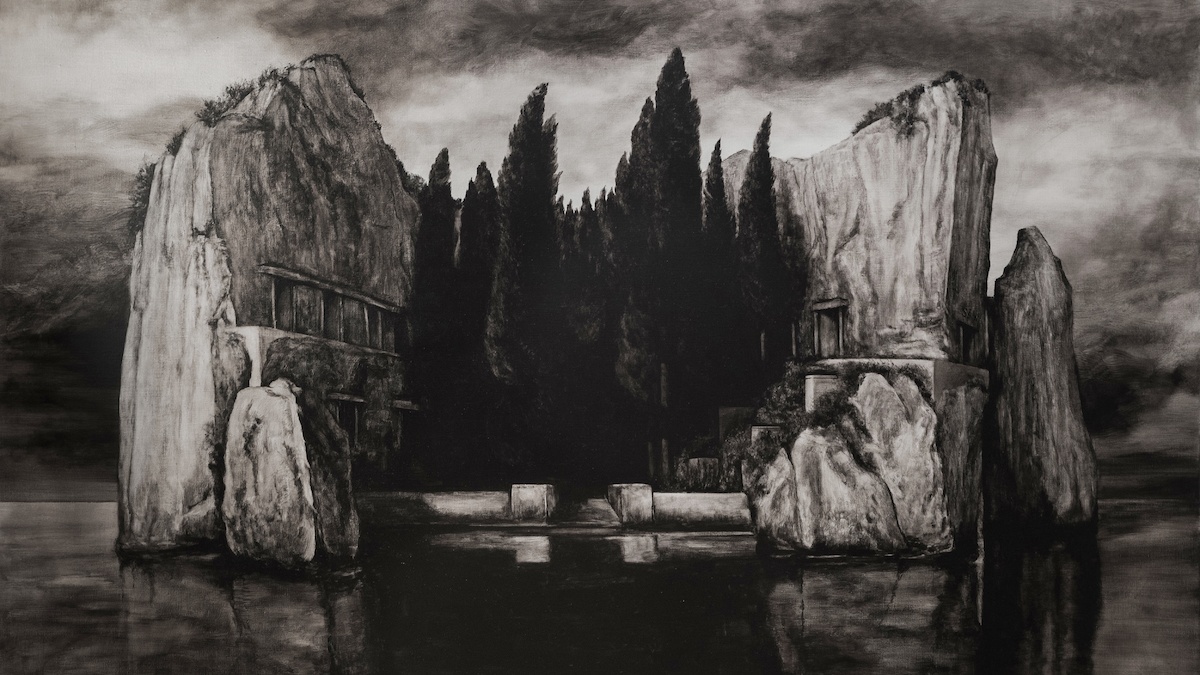In 1907, Sergei Rachmaninov saw a black and white reproduction of Isle of the Dead, a painting by the Swiss symbolist artist, Arnold Böcklin. The haunting dream image depicts a solitary rowboat carrying a coffin, bound for a desolate, rocky island. The scene suggests the mythological River Styx and the transition of a recently deceased soul to the afterlife.
The image affected Rachmaninov deeply and inexplicably. It was a powerful, immediate, and spontaneous creative trigger which seemed to unleash music which demanded to be brought to life. The composer later described the mysterious experience saying, “When it came, how it began—how can I say? It came up within me, was entertained, written down.” When Rachmaninov saw Böcklin’s original color painting, he discovered, to his disappointment, that the initial, mystical revelation could not be recaptured. He went so far as to say, “If I had seen first the original, I, probably, would have not written my Isle of the Dead. I like it in black and white.”
The music begins in the shadowy depths of the orchestra with an ominous, incessantly repeating motif in the irregular meter of 5/8 time. It’s something akin to the hypnotic rise and fall of water, the persistent and arduous plying of oars, or even the continuous, life-sustaining cycle of inhaling and exhaling. Fragments of the Dies irae, the ancient Latin chant of the dead, emerge like fleeting ghosts. This motif, which returns so often throughout Rachmaninov’s music, seems to be wired into the musical DNA of this piece. You can hear it begin to take shape from the opening bars. Later, it becomes fully formed (listen to the violins here).
Isle of the Dead is a drama of conversing instrumental voices. It moves from the grim shadows of the opening to moments of quiet lament and soaring, lush sensuality. Throughout all of this, the Dies irae haunts the music as a persistent and unrelenting Power. Around the work’s golden mean, the obsessive recurrence of the Dies irae motif reaches a terrifying and awesome climax. In this section (beginning around the 14:47 mark), listen to the way the motif emerges in multiple voices amid ever-mounting tension as the music continuously rises higher. This climax reaches its limit with a series of furious, cymbal-augmented raps reminiscent of Tchaikovsky. The hushed, impassive music which follows is perhaps the most spine-chilling of all. As if to say, “I’m still here,” the Dies irae returns in a trance-like prolation canon initiated by the clarinet and quietly shivering string tremolo. Rachmaninov’s haunting Isle of the Dead ends where it began—with a return to the dark, watery depths.
Five Great Recordings
- Rachmaninov: Isle of the Dead, Op. 29, Sir Andrew Davis, Royal Stockholm Philharmonic Orchestra (This 1998 recording is featured above). Amazon
- Rachmaninov’s historic 1929 recording with the Philadelphia Orchestra
- Dimitri Mitropoulos and the Minneapolis Symphony Orchestra (1945 recording)
- Mariss Jansons and the St Petersburg Philharmonic Orchestra
- Evgeny Svetlanov and the USSR Symphony Orchestra
Photograph: A black and white reproduction of “Isle of the Dead,” Arnold Böcklin


Hi Timothy !
Sorry, but you’ve just forgotten the outstanding recording of the great Fritz Reiner conducting the Chicago Symphony Orchestra which outclass all others !…
Best Regards.
I agree that this is a great recording, Claude. Here it is: https://youtu.be/V5-PeW66-W8
Definitely a more intense performance, allowing us to hear more of the details you wrote about. Quicker, more fervent ‘rowing’ tempo and clearer English horn and viola lines. Love it! 🎶
“If I had seen first the original, I, probably, would have not written my Isle of the Dead. I like it in black and white.”
Do you know where this quote comes from ?
Hi Matt, One of the sources for this quote is Eero Tarasti’s Semiotics of Classical Music: How Mozart, Brahms and Wagner Talk to Us, page 385